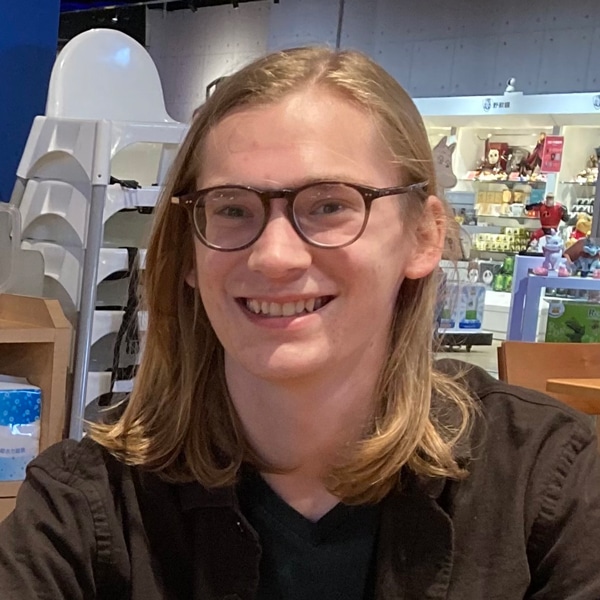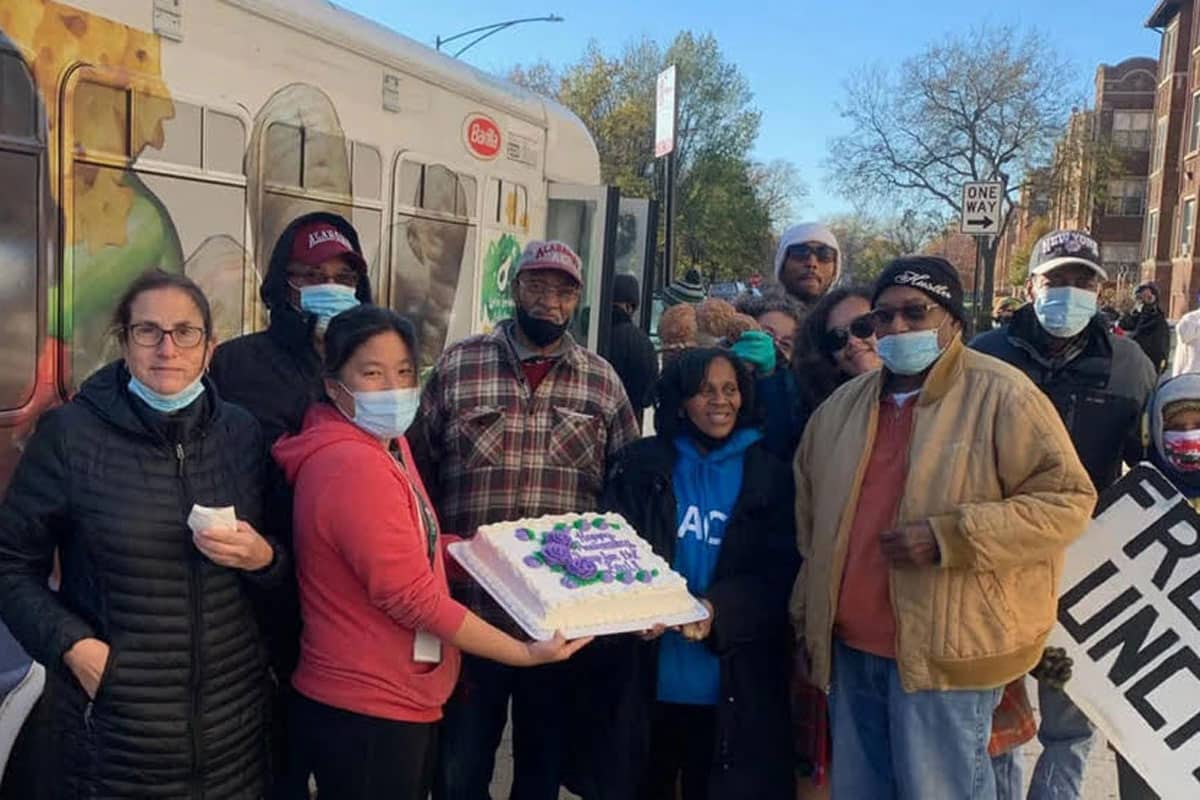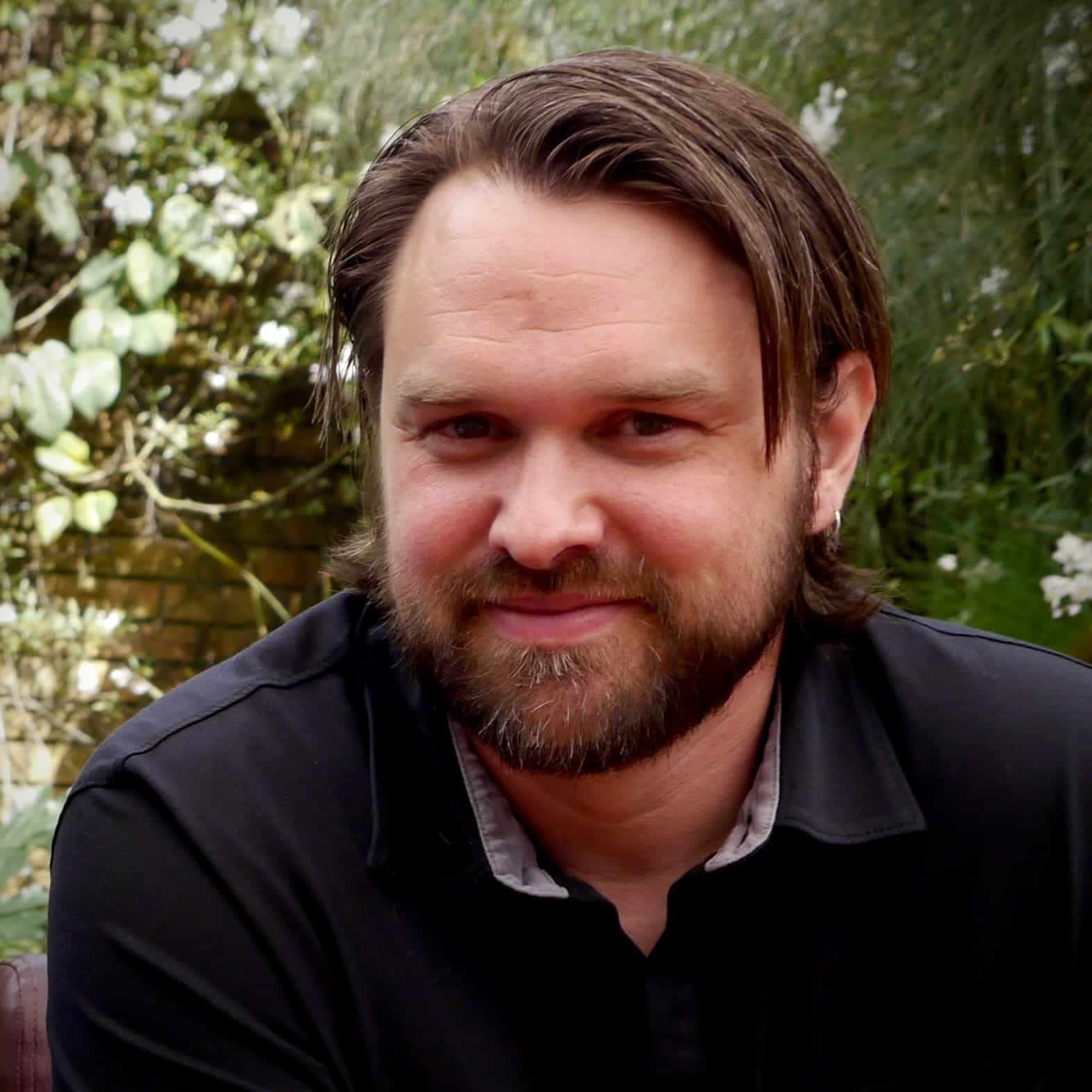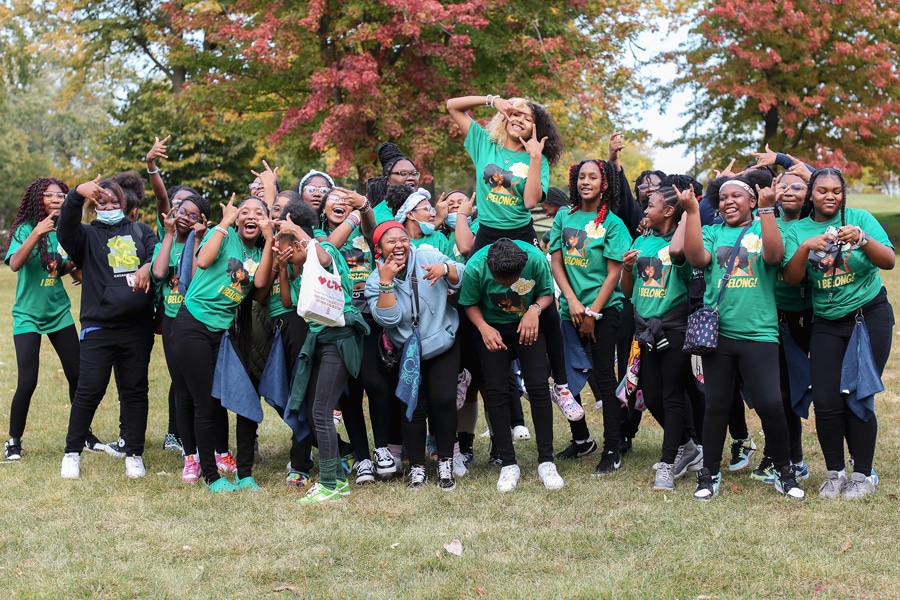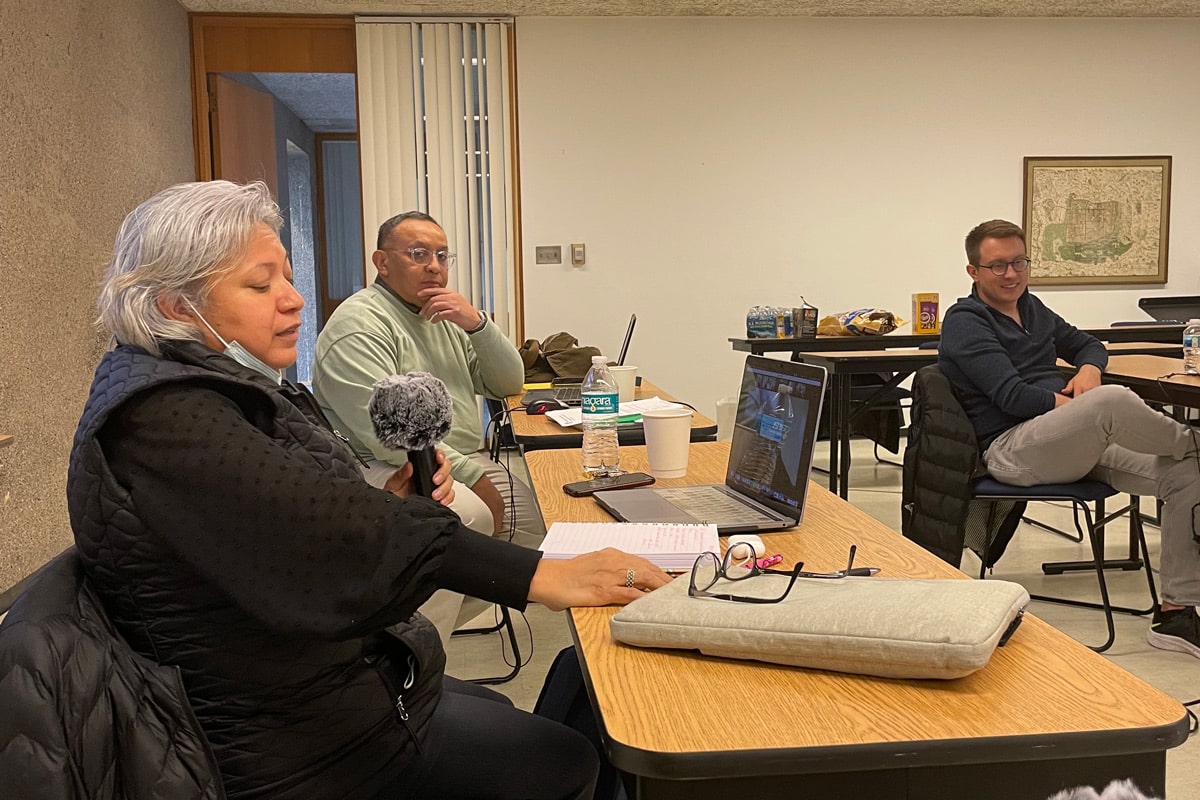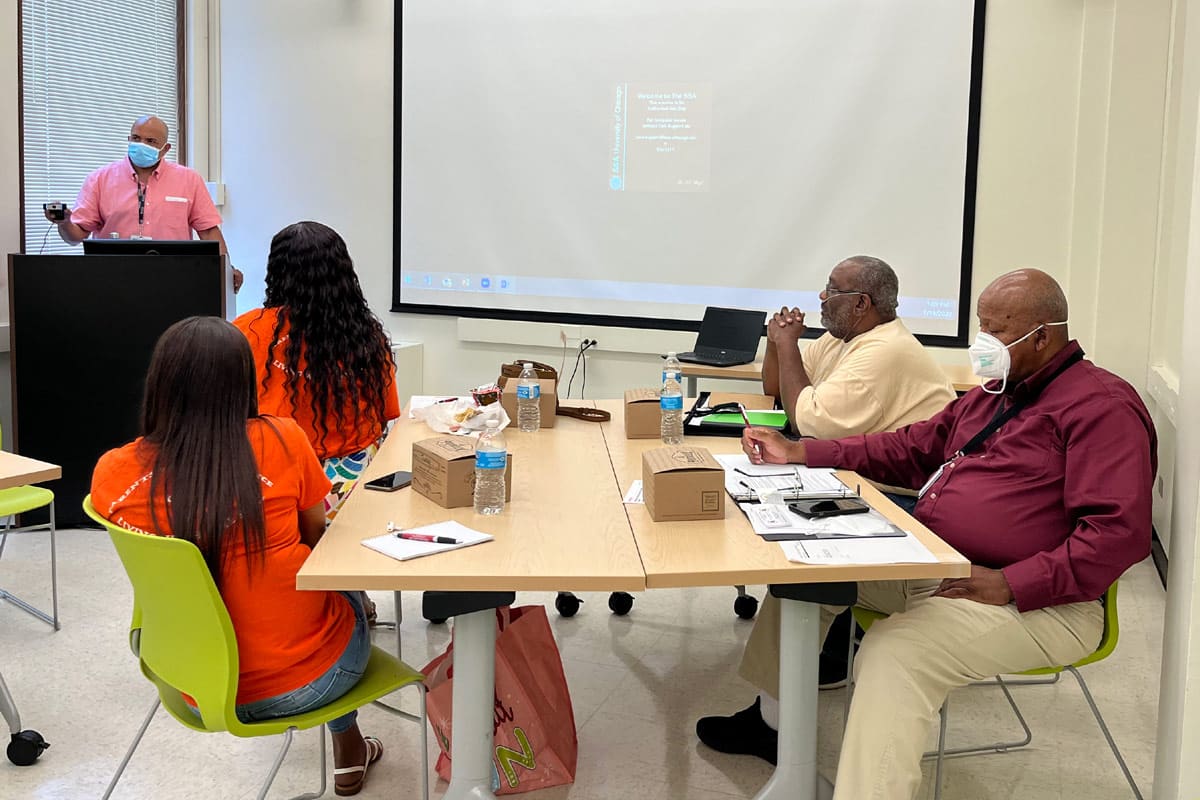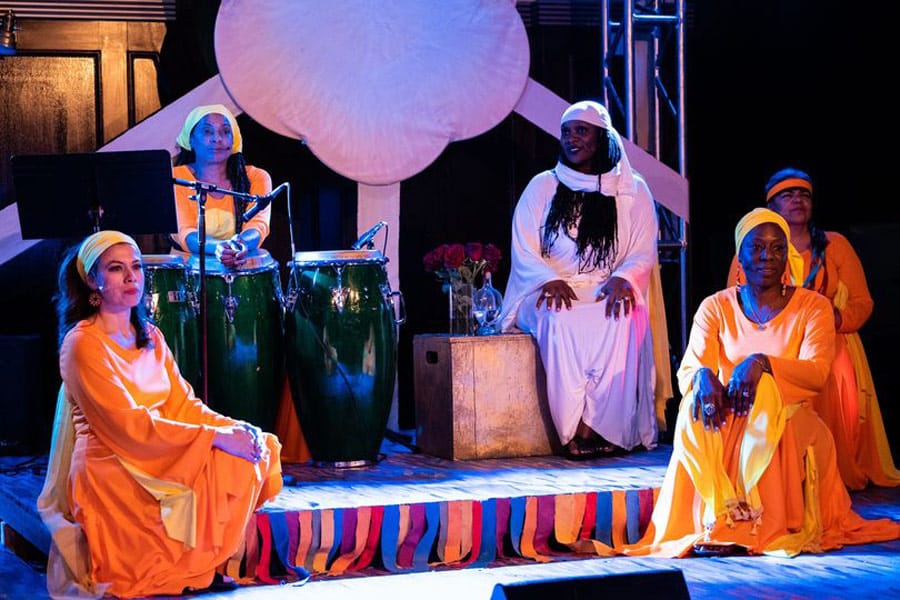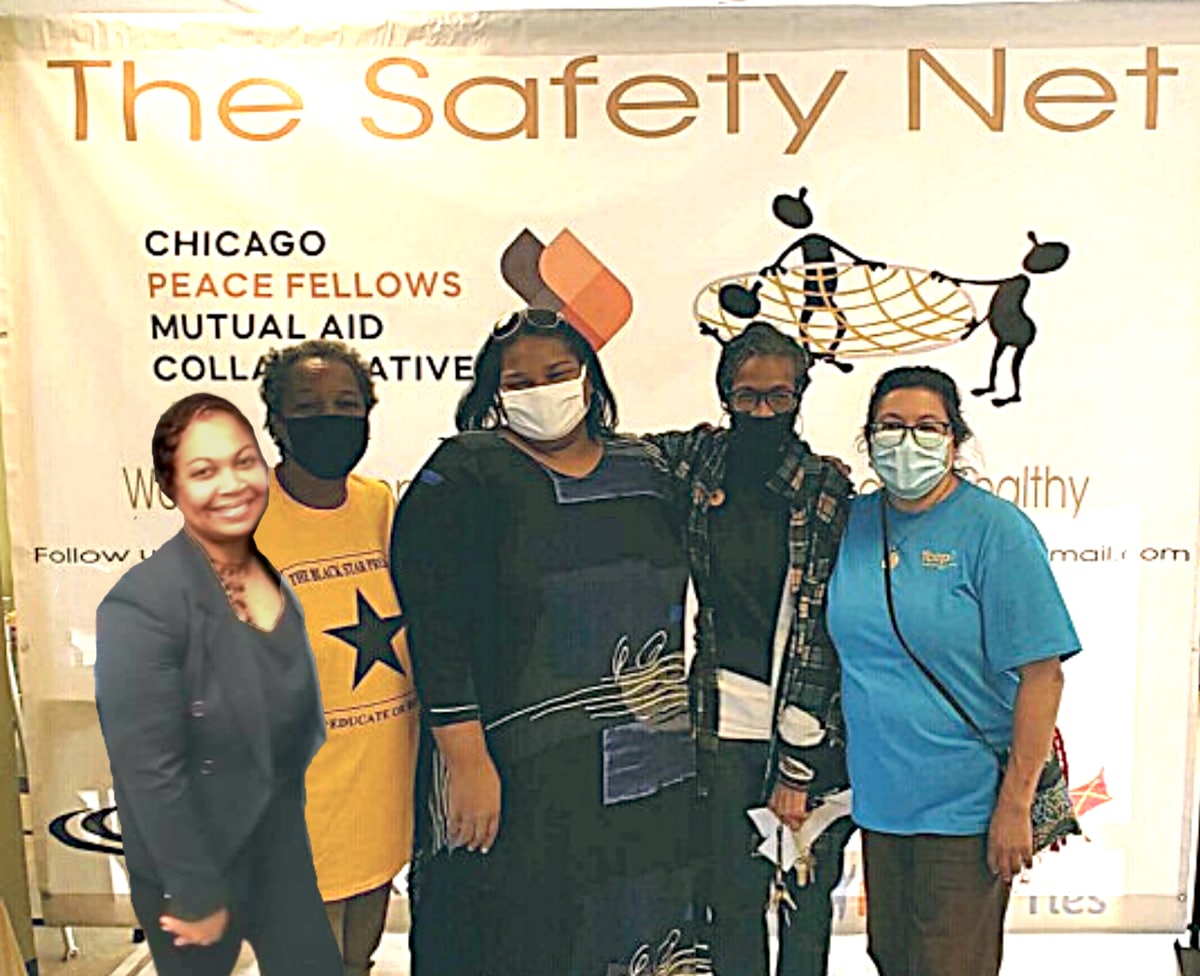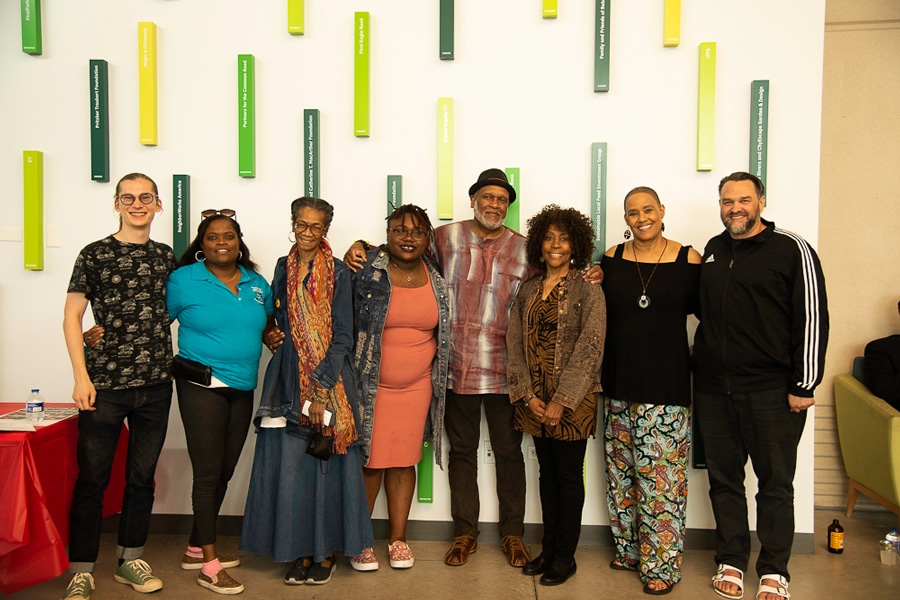Parade of Hearts Across Chicago
2020 Chicago Peace Fellow Cosette Nazon-Wilburn unveiled ten community-created hearts that will be showcased across neighborhoods in Southside Chicago on September 8th. These five-foot tall fiberglass hearts form the “Parade of Hearts,” a community based initiative designed by the LUV Institute with support from the Chicago Peace Fellows Mutual Aid Collaborative.
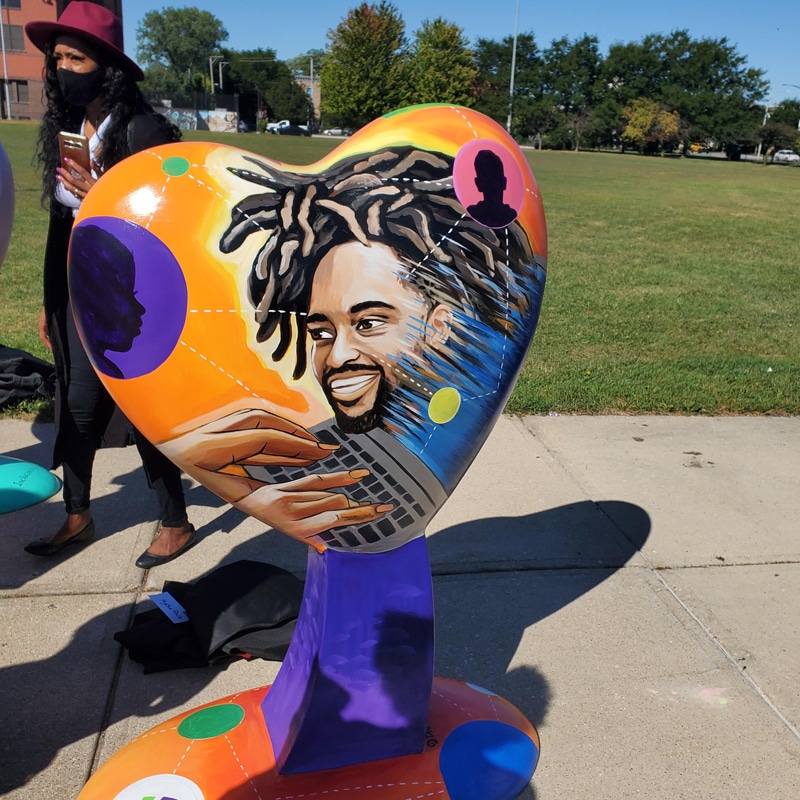
The hearts were collaboratively designed by peace circles in ten neighborhoods: Chatham, Douglas, Grand Boulevard, Greater Grand Crossing, Hyde Park, Kenwood, Oakland, South Shore, Washington Park, and Woodlawn. The peace circles provided an opportunity for the LUV Institute to partner with three other Chicago Peace Fellows: David Gonzalez, Michelle Day, and Jennifer Maddox.
In the peace circles, artists and community members came together and discussed how they would like to showcase their neighborhood’s “new normal” in light of the COVID-19 pandemic and recent political tensions.
Ten hearts were showcased at the launch of the Parade of Hearts; each heart will be placed in a South Side community.
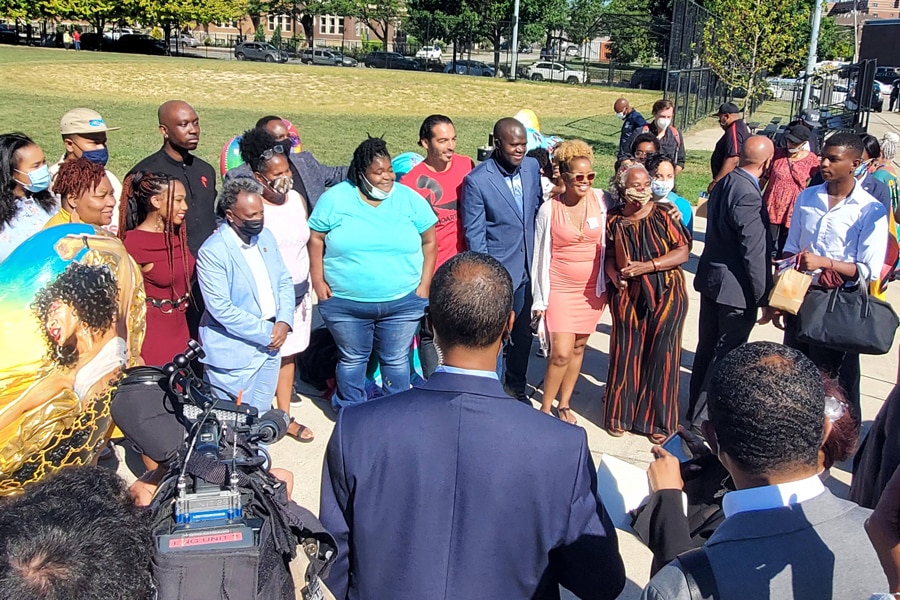
Creating a Parade of Hearts with Communal Visions
Artists acted as community representatives, expressing communal visions of neighborhoods that are beautiful and resilient. One local artist that worked on the project was Damon Lamar Reed, who created hearts for two communities, Nichols Park and Douglas. The heart that he created with the Douglas community is centered around a theme of trust with a man covering a woman’s eyes at its center and a background of stitched patchwork. The patchwork of the heart is meant to evoke memories of mothers patching ripped clothes and making them stronger than they were before. Damon and the Douglas community see this heart as symbolic of their community’s resilience and ability to memorialize the past while creating a stronger community.
Through the parade of hearts, the LUV Institute hopes to revitalize South Side communities through introducing a large-scale public arts project. Cosette emphasizes the importance of bringing arts programs to communities that are often left out of public arts initiatives. The Parade of Hearts aims to act symbolically as an expression of love trumping all, but also to bring prosperity to the featured neighborhoods. She hopes that people will come to visit the hearts and bring tourism to neighborhoods of Chicago that don’t often receive it.
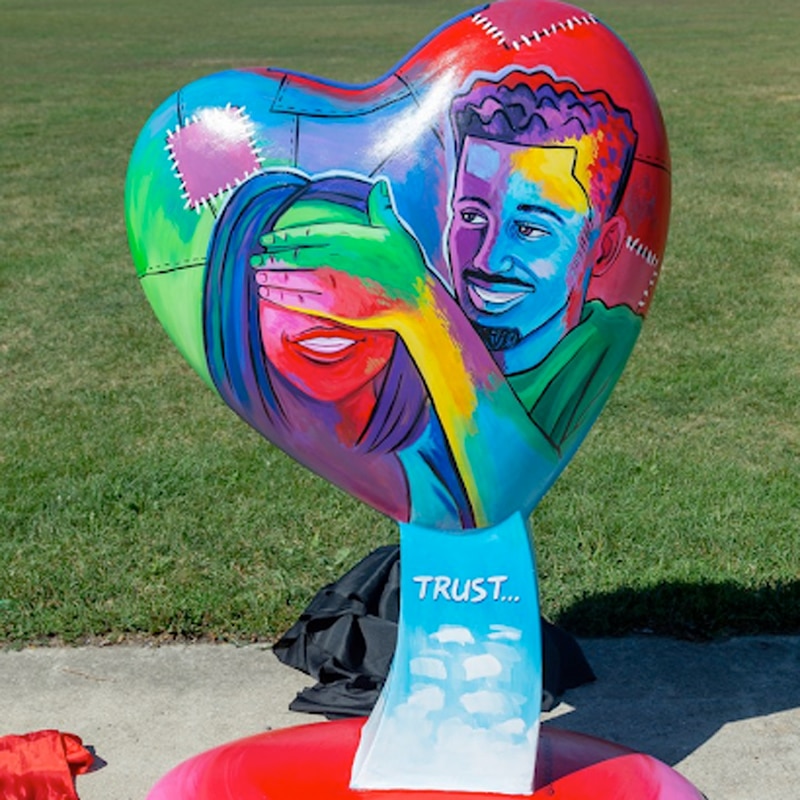
Hearts Will Show that Love Trumps Hate
The process of creating hearts was chronicled by a videographer who will release a documentary talking about the organizations involved in helping neighborhoods design their hearts as well as histories of the neighborhoods themselves. Next year, the LUV Institute will facilitate a digital treasure hunt around the Parade of Hearts, in which people can explore virtual histories of the hearts and their surrounding neighborhoods.
The hearts have started many conversations about peacebuilding in Chicago and many people and institutions have reached out to Cosette, moved by the Parade of Hearts’ message that love can trump hate. For its launch, the Parade of Hearts raised $115,000, surpassing its goal.
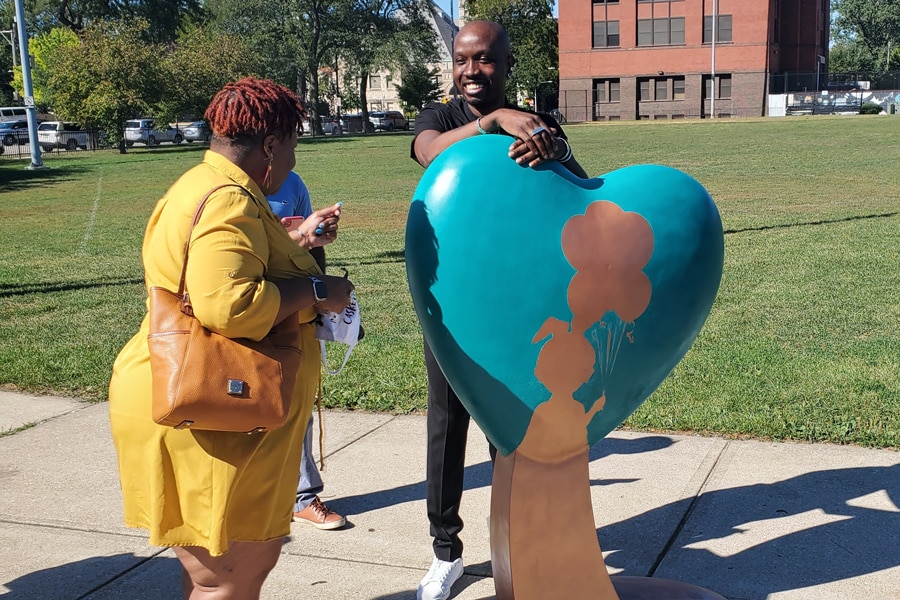
The LUV Institute intends to use this money as a seed for a larger community outreach program. Cosette envisions that soon, all 77 community areas in Chicago will be able to create hearts and that money raised through the parade can be used for restorative justice projects. In the future, she plans for the LUV Institute to partner with other local non-profits to launch similar events and initiatives that integrate the arts with community-building and trauma recovery.
Chicago’s First Annual Sukkah Design Fest Brings Together Social Justice and Design
By Zeki Salah, Facilitator, Mutual Aid Collaborative
The first annual Sukkah Design Festival was held on October 9-16, showcasing North Lawndale’s Jewish history and providing social services to the community. Reshorna Fitzpatrick, 2019 Chicago Peace Fellow and Executive Pastor of the Stone Temple Baptist Church, was a member of the organizing committee, which included community-based organizations and design firms. These groups brought the community together to explore the history of North Lawndale through collaborative design projects and built relationships centered around social justice.
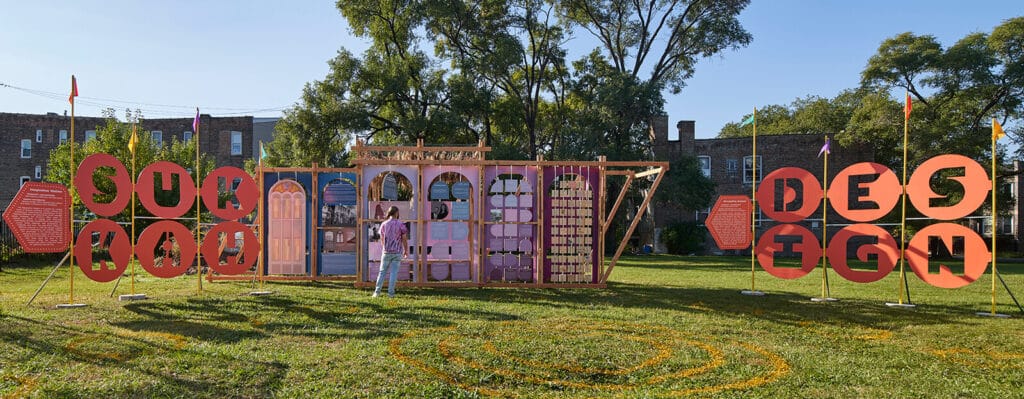
Pastor Reshorna became involved with the Sukkah Design project through her work with the Lawndale Pop-up Spot, a museum housed in a shipping container created by Chelsea Ridley, Jonathan Kelley, and members of the North Lawndale neighborhood. They built the Lawndale Pop-up Spot on a lot owned by Stone Temple Baptist Church, now called the Love Blooms Here Plaza. The Lawndale Pop-Up Spot explores the history of North Lawndale through rotating community-designed exhibits. Given the history between Pastor Reshorna and the Lawndale Pop-up Spot, she gave an enthusiastic yes when Jonathan and Kelly proposed the Sukkah Design Festival. They held the festival from October 9th to October 16th on the Love Blooms Here Plaza, across the street from Stone Temple Baptist Church. The main attraction for the event was a series of Sukkahs which aimed to promote social justice and explore cultural legacy through design.
The Sukkah Design fest created three Sukkahs, temporary outdoor structures, to celebrate the Jewish holiday, Sukkot. Sukkot celebrates the end of harvest time and involves the creation of Sukkahs where community members can gather, eat, and spend time with one another. The festival split participants into three teams. Each team included a Chicago-based design firm and a community-based organization that collaborated to design a Sukkah with a social justice element.
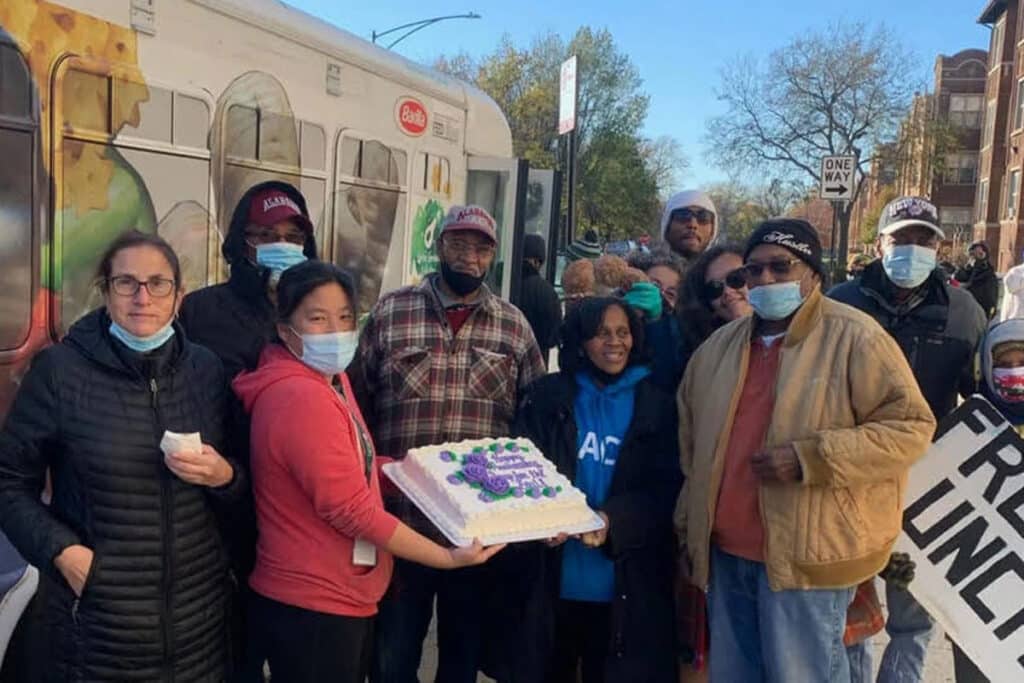
The Young Men's Educational Network (YMEN) partnered with the firm Human Scale to put together a “Giving Sukkah,” where people could receive food and flowers grown by the community. Community-grown food and flowers are a staple of the Love Blooms Here plaza, which has also housed community gardens designed by Pastor Reshorna and another 2020 Chicago Peace Fellow, Annamaria Leon. The Giving Sukkah has now moved to YMEN’s headquarters on Pulaski Boulevard.
Stone Temple Baptist Church worked with the firm New Office to design a micro-museum that explores the history of Stone Temple from 1926 to the present day. The exhibit examines the various stages the building went through as both a synagogue and a church. Current community members were also involved in its design as the team explored what residents love about North Lawndale. Through interviews and community input, the team brought the present neighborhood into conversation with its history.
Men Making a Difference and Open Books – North Lawndale Reads partnered with the Chicago Design Office and Made In Englewood. Together they created an inter-generational “book nook,” which acted as a free library. This Sukkah also served as a space where people of all ages could come together to read or play games. Collectively, all three Sukkahs tackled the issue of food accessibility, explored community assets, and built relationships between people in North Lawndale. Each Sukkah functioned as a hub for discussions, music, and food before they relocated to more permanent sites.
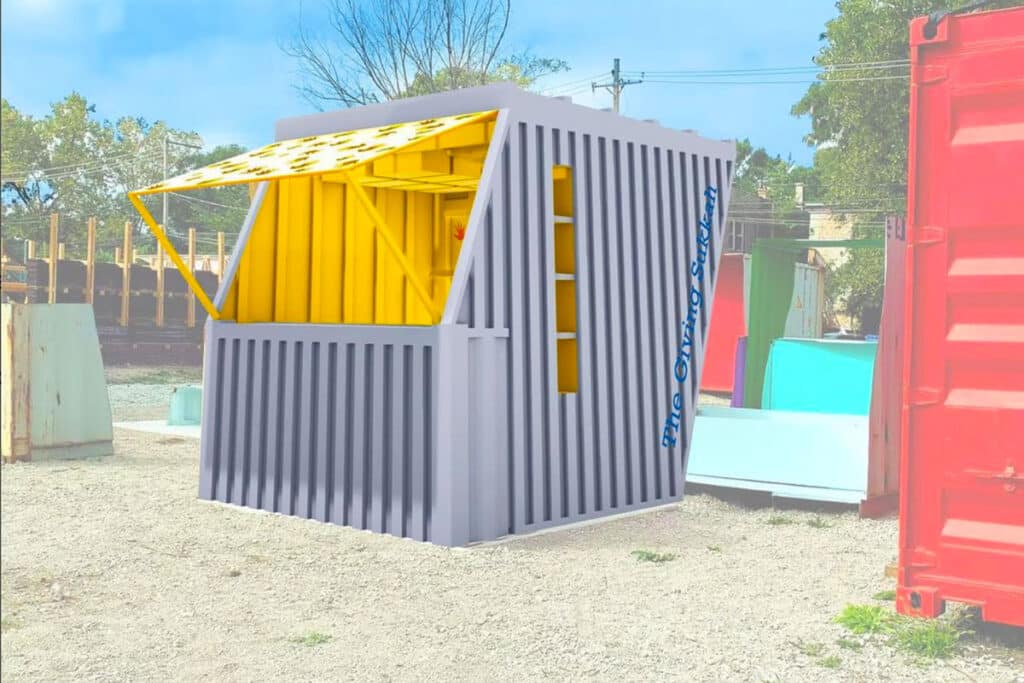
Programming at the Sukkah Design Festival brought members of the North Lawndale community together through meals and conversations about their neighborhood. Food was often a central element of the celebration: Stone Temple held their weekly “Soup for the Soul” food drive within the festival grounds, and various faith-based organizations partnered to organize interfaith dinners throughout the week. Pastor Reshorna noted that “nothing brings people together more than food,” a sentiment that inspired a community clean-up event in which participants celebrated their work picking up trash with a free meal and conversation about environmental justice.
As people gathered around food, festival organizers worked to draw their attention toward the built environment surrounding them. Community organizations gave tours of various Peace Parks in North Lawndale which aim to reactivate vacant lots. The architects and designers of the Sukkahs also held guided tours during Open House Chicago, a city-wide architectural festival. The Sukkah Design Fest inspired conversations about how the built environment can impact issues such as segregation and resource shortages. By gathering the community around food and leading discussions about their neighborhood, the Festival aimed to build new partnerships between designers, faith leaders, and community activists to address these problems.
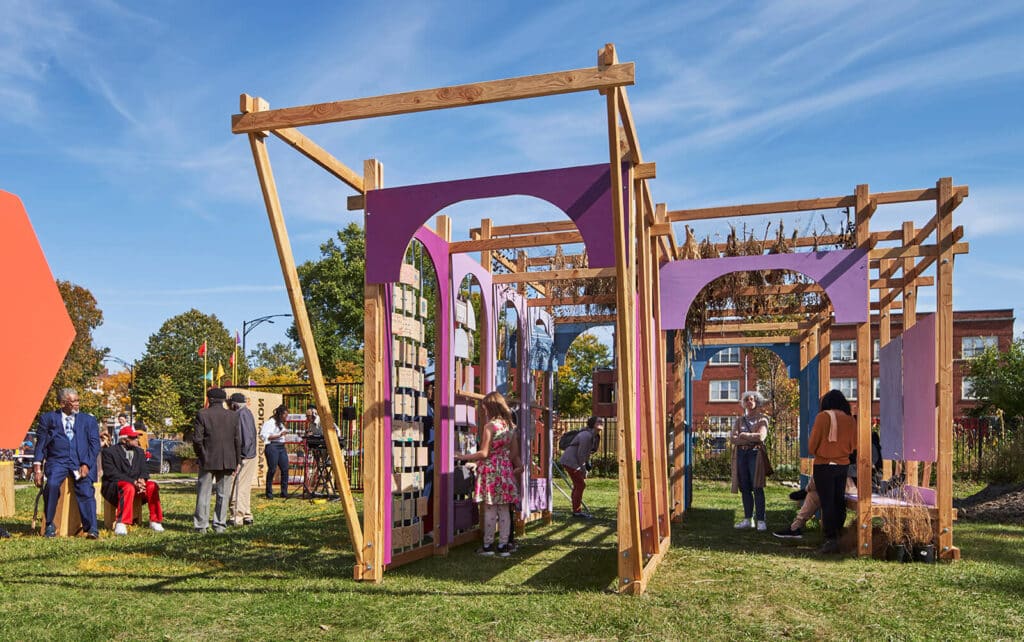
The Sukkah Design Fest built relationships amongst residents in North Lawndale and connected them to different organizations around the city as they planned music, food, and cultural programming. Architects, community members, and community organizations all came together to unite diverse groups of people that would have otherwise not likely come into contact with one another. Sukkot is a holiday associated with food, gathering, and the harvest. The festival used these themes to encourage North Lawndale’s predominantly Black population to explore their neighborhood’s Jewish history alongside traditions of fellowship and kinship. These relationship-building events provided opportunities for residents to make a difference in their community and plan social justice projects from the ground up.
By uniting a diverse range of actors and facilitating collaboration, the Sukkah Design Festival provided valuable assets to an underserved community and empowered residents. The Stone Temple Baptist Church would like to make the Sukkah they designed alongside New Office a permanent mini-exhibition within the church. The exhibit would memorialize the cooperation achieved through Black and Jewish communities through the design festival and preserve a valuable historical artifact to North Lawndale. Stone Temple is currently collecting donations to help fund the installation of the mini-exhibit.
Generation Now Helps Teens Produce New Talk Show
By Zeki Salah, Facilitator, Mutual Aid Collaborative
The Chicago Peace Fellows Mutual Aid Collaborative is introducing teenagers to work in the media industry through a project called Generation NOW. Generation NOW was conceived by Messiah Equiano, a 2021 Chicago Peace Fellow, and aims to provide opportunities for young people to work on a teen talk show that addresses everyday issues that teenagers face. The program pays teenagers to produce, direct, and act in the show and provides them with a safe environment to express their thoughts.
Messiah originally thought of the idea of a teen talk show in 2014 and pitched the idea to the television station WCIU. The project was initially based on a show that appeared on BET in the 90s and early 2000s called Teen Summit. Teen Summit provided a platform for teenagers to talk about the everyday issues they face and brought these issues into perspective within an open and safe environment. Messiah thought the idea of a teen talk show was valuable and conceptualized Generation NOW as a similar program that would also allow the young people to get involved in aspects of production.
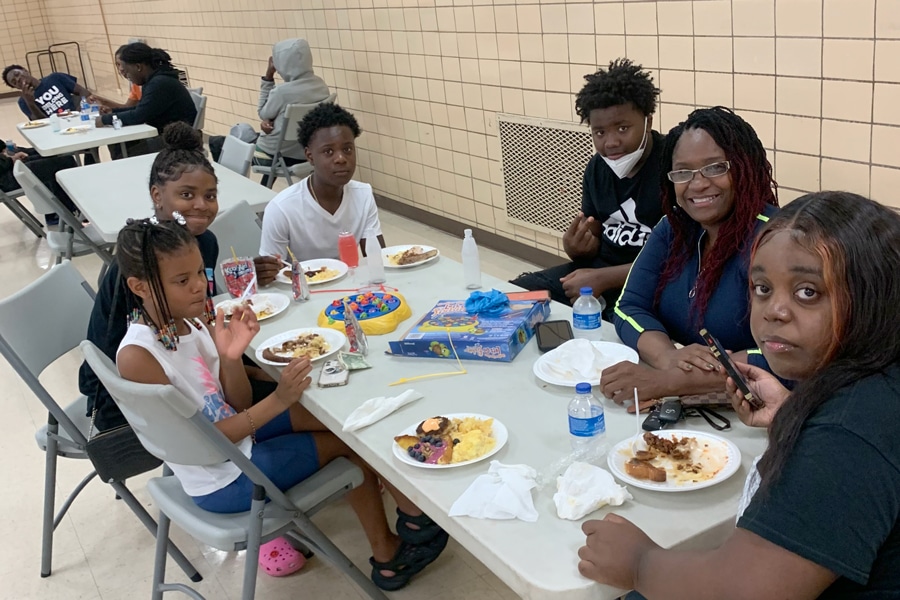
While the station turned down the pitch, Messiah persisted and applied for a grant from the Chicago Community trust to shoot a pilot episode of Generation NOW. He received the grant from the Chicago Community Trust in 2019 and filmed the pilot at Lawndale Community Academy. This experience showed him how therapeutic and empowering a platform for teens to express their issues could be. Since then, he has been working to secure funding to film more episodes of Generation NOW, including the August 5 filming that was funded by the Mutual Aid Collaborative.
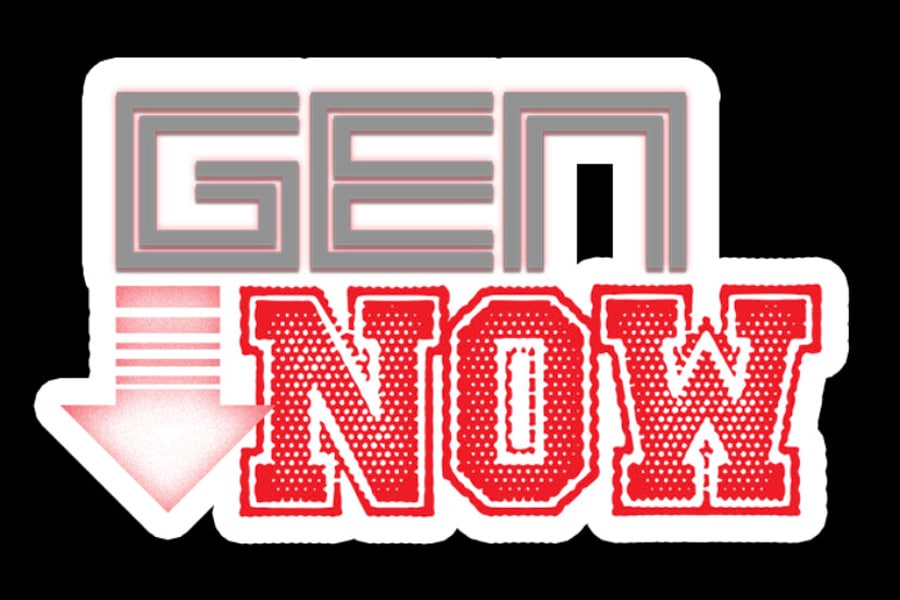
The Mutual Aid Collaborative is made up of 60 Black and Brown leaders and committed allies who live and work in the communities they serve on the South and West sides. They have raised over $86,000 to support several active projects, including Generation NOW. The Mutual Aid Collaborative met and collaboratively voted in May to provide Generation NOW with the funding to film another episode at the Foster Park District.
Generation NOW aims to provide young people with a setting to be open about their opinions, while also providing them with experience with different aspects of television production. Teens are invited to work on the project as writers, production members, or actors and are compensated for their work. On August 5th, the funds provided by the Mutual Aid Collaborative were used to pay 10 teenagers $250 each for their involvement in a day of filming. Funds were also used to provide them with meals and entertainment and also paid for a camera crew. Generation NOW aimed to provide the teens involved with a new opportunity to express themselves without judgment.
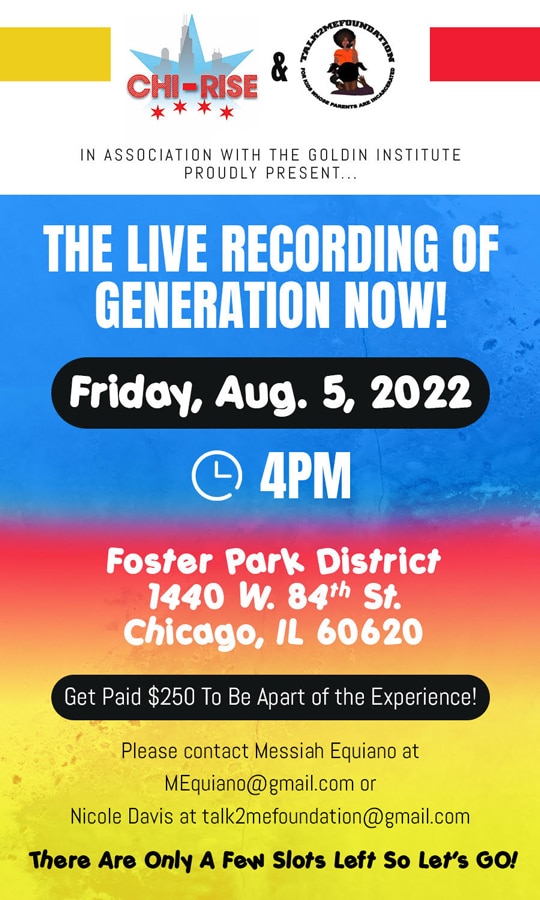
The young people were not only provided with food and time to get to know each other, but they were also told not to laugh at each other or dismiss opinions and were assured that the raw footage from the filming would not become publicly available.
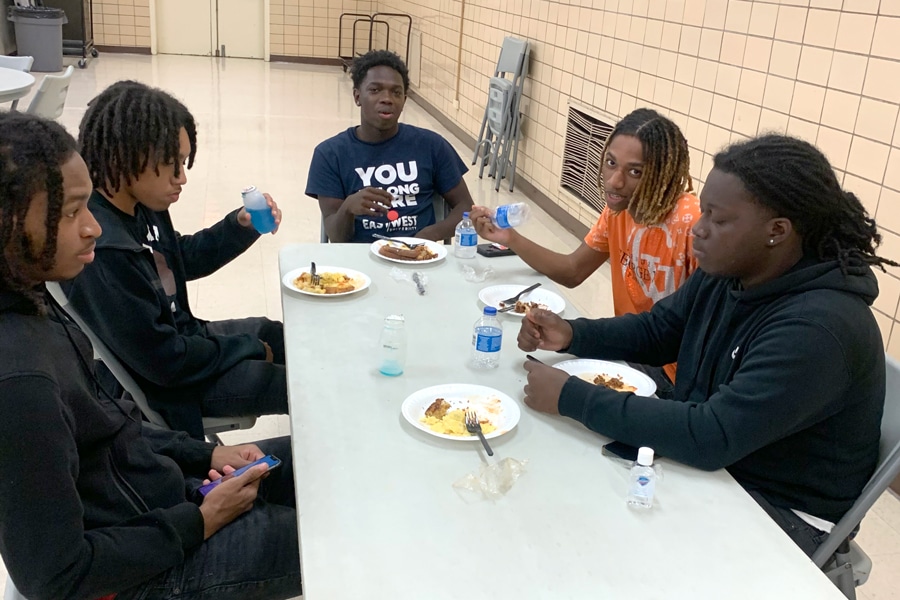
The filming of Generation NOW on August 5 was a collaborative effort between Peace Fellows. Alongside Messiah, Nicole Davis and the Talk to Me Foundation brought in actors and rehearsed together. As part of the filming, Nicole and her teens performed a skit where a woman accuses a man of stealing her purse, he denies stealing her purse, and she comes back with her brother to confront the accused man. At the end of the skit, someone approaches the woman and informs her that she left her purse in the bathroom and she apologizes. This scene was modeled after the experiences of the teens themselves, who gave input on how the scene might unfold.
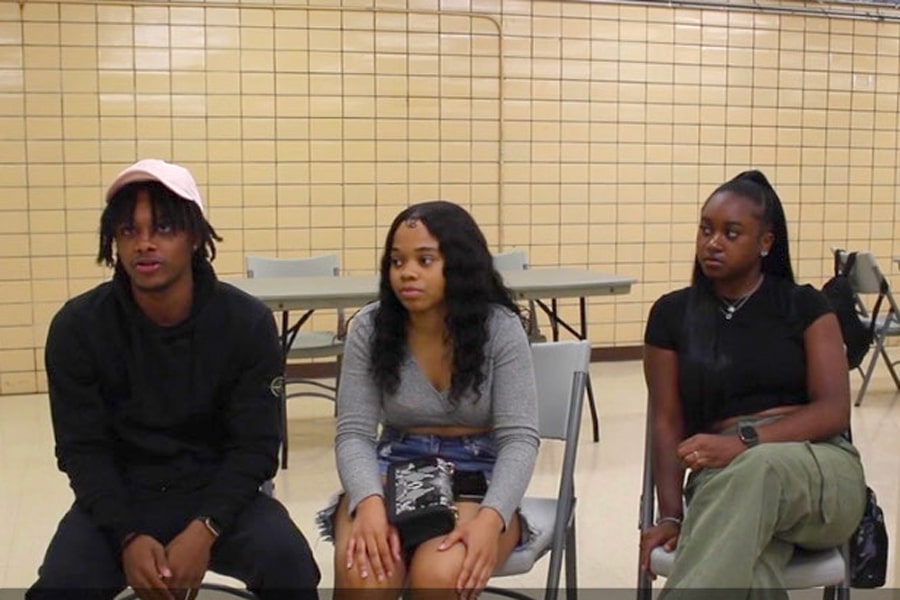
While Nicole led the rehearsal, the script of the conflict and resolution was developed by the teens. For instance, when asked what they would do if confronted about stealing, all of the young men at the filming responded that they would stand their ground during the confrontation and would not run away. The filming not only provided the teens involved with a platform to voice their beliefs without judgment, but also with a chance to enact their visions in a production and to work together collaboratively.
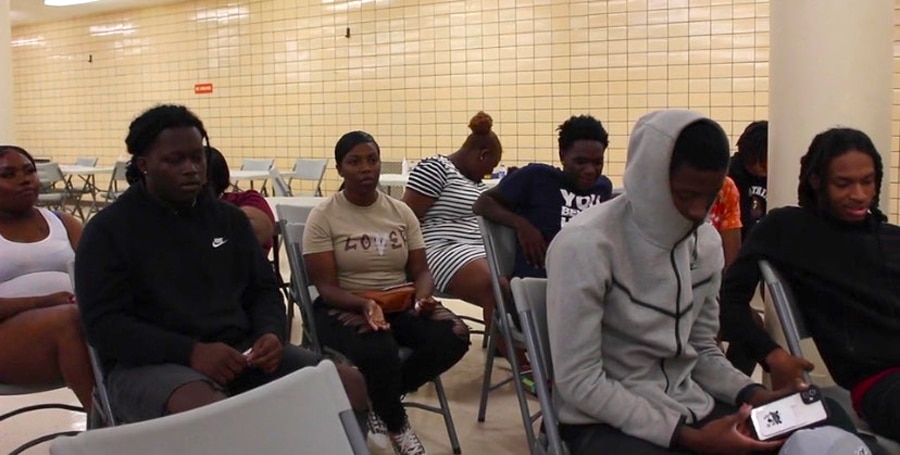
The response of the young people involved in Generation NOW has shown that the program is both therapeutic and empowering. Messiah spoke to the experience of the teens involved as they were provided with a platform to speak about topics like dating and conflict resolution: “Human beings hold onto so much in their hearts and their minds related to their experiences... Even if someone doesn’t express themself, just hearing another person make themselves available can make them feel better.” By continuing to provide this platform for teens and compensating them for their involvement, Messiah believes he can first them away from activities that might lead to violence:
[Generation NOW is about] getting a gun from someone’s hand and a camera into it. I’ve seen this in real life, I’ve seen people love it... you put a camera in his hand and he loves it. You’ve got to give them alternatives and have them get paid for it.”
Messiah’s organization, CHI-RISE, is looking for funding to continue to produce episodes of Generation NOW. They are also looking towards expanding the programs to different communities, and looking specifically at communities with higher risks of violence. Through community collaboration, they are hoping to help teenagers find work on the project during summer and winter recesses from school. Ultimately Messiah hopes to create a sustainable model for Generation NOW by getting members of the community involved and having them watch the show. Through creating content that gives back, Generation NOW aims to create safer and more connected communities.
Celebrating the Chicago Day of the Girl
by Zeki Salah, Mutual Aid Collaborative Facilitator

On October 11, the Girls Like Me Project, Inc. hosted the 11th annual Chicago Day of the Girl at the South Shore Cultural Center. The event coincides with the International Day of the Girl, which is an international observance day established by the United Nation on October 11, 2012 to increase awareness of gender inequality faced by girls worldwide and to support more opportunities for them. The Chicago Day of the Girl focuses on recognizing and providing opportunities for Black girls ages 13 to 18 years old in the City of Chicago.

This year, the theme of the Chicago Day of the Girl was “I Belong” and the programming was aimed towards reclaiming spaces for Black girls that often feel inaccessible. La’Keisha Gray-Sewell, a 2020 Chicago Peace Fellow and the Executive Director of the Girls Like Me Project spoke to the importance of reinforcing the girls’ right to spaces throughout the city: “Many girls feel like they only belong in certain spaces and that they are confined to their neighborhoods. So we wanted to build a sense of belonging: they belong to this city and that this city belongs to them.” The Chicago Day of the Girl worked to address the way the city is segregated by race, class, and income by showcasing how different organizations and resources can be utilized to celebrate and center the voices of Black girls. The South Shore Cultural Center also made for a significant venue because it gave the girls an opportunity to be in an establishment that is seen as exclusive.

Chicago Public Schools across the city participated in the Chicago Day of the Girl, with 253 girls attending in total. The University of Chicago Charter School Woodlawn, Gary Comer Charter School, and Nicholson STEM Academy were some of the schools that were connected to the Chicago Day of the Girl through partnerships with the Girls Like Me Project, Inc. The event was held from 10am - 3pm, allowing the girls to leave the classroom and receive educational enrichment outside of their schools.

As an educational enrichment opportunity outside of the classroom, the Chicago Day of the Girl was able to address issues that receive limited attention in schools, allowing programming to be gender responsive and internationally oriented. The day’s activities aimed to make the girls in attendance feel like they belong and are included in a global empowerment conversation. The Chicago Day of the Girl originally grew out of the Girls Like Me Project’s Global Connections program, which aimed to show girls in Chicago what girlhood looks like in other spaces around the world. This has influenced programming to have an international reach, that aims to not only bring the voices and perspectives of Black girls into international conversations, but also to provide resources that help them travel internationally.

Girls who attended the Chicago Day of the Girl were provided with connections to the global community and opportunities for international travel by local international organizations. WorldChicago, an internationally-oriented nonprofit focused on citizen diplomacy, presented their Youth Diplomat program to the girls in attendance. This program admits students to engage in cross-cultural conversations with international peers and attend lectures and workshops with global and Chicago area academics, government officials, and community leaders. Tiffany Smith, a travel writer from Bronzeville, also shared her experience traveling outside of the country and the barriers to travel she faced as a Black girl. The Global Strategists Association addressed some of the challenges girls might face by sharing information about passports. The Girls Like Me Project will also sponsor passports for three girls who attended the Day of the Girl, as well as African ancestry tests. Collectively the organizations involved provided tools for Black girls to engage with girlhood internationally while also showing that their voices are needed in an international space.

Organizations across the city of Chicago also collaborated to show their commitment towards supporting, celebrating, and amplifying the voices of Black girls. Damon Reed, a local Chicago artist, came and showcased murals that girls involved in the Girls Like Me Project painted with his support. The murals depict missing Black girls whose stories have not received significant media coverage. Dr. Ruby Mendenhall of UIC Champaign-Urbana also created an exhibit which was featured at the Day of the Girl by working with the mothers and daughters of the Girls Like Me Project. Their exhibit featured portraits of what brings them joy and healing. These projects showed the girls in attendance the importance of their experiences and how their stories can be told in a powerful and influential way.

The Chicago Day of the Girl provided Black girls from Chicago with a sense of belonging within both local and global communities and emphasized their capacity to enact change. The girls who attended were given tools for advocacy by the participating organization and a platform for self-expression. Local talent was also showcased, with dance performances from the Girls Like Me Project, music, a teen talk show, and a performance from Dee Dee Davis of the Bernie Mac Show. Reflecting on the day’s events La’Keisha Gray-Sewell said, “this day was all about Chicago girls and uplifting them and providing them with a platform to celebrate themselves.”
Mutual Aid Collaborative Discusses How Violence Spreads with Dr. Andrew Papachristos
By Zeki Salah, Facilitator, Mutual Aid Collaborative
On Tuesday, August 23rd, the Chicago Peace Fellows Mutual Aid Collaborative met with Dr. Andrew Papachristos, Director of the Northwestern Neighborhood & Network Initiative. The meeting was part of the Mutual Aid Collaborative Civic Partners Series, which aims to create connections between individuals and organizations that work to build peace and prevent violence.
Dr. Papachristos studies social networks and how they can help activists understand and predict who is at the highest risk of becoming a victim of gun violence. He met with members of the Chicago Peace Fellows Mutual Aid Collaborative, a network of 60 Black and Brown leaders and activists who live and work in the communities they serve on the South and West sides. Fellows came in person and online to strategize with Dr. Papachristos about how they could act to prevent the spread of violence.
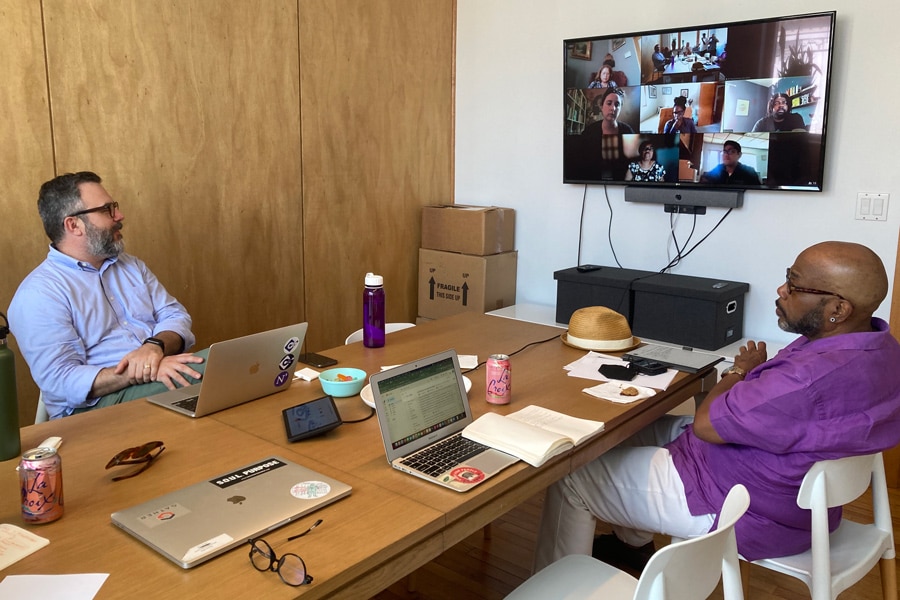
Dr. Papachristos’s research around gun violence gave Fellows insight into how the spread of gun violence can be predicted and preemptively addressed. As he presented his research, he made it clear that gun violence primarily spreads through a concentrated segment of the population. This finding suggests that most victims of gun violence either know each other or are linked together by only a few degrees of separation.
To illustrate how gun violence concentrates within particular communities, one section of Dr. Papachristos's presentation focused on how most gun violence injuries within cities affect a small proportion of the overall population. Data collected in Chicago between 2012-2016 showed that more than 70% of all subjects of gun violence are within social networks containing less than 5% of the city population, with 89% of those shootings occurring within a singular network. This insight is particularly pertinent to community activists and local organizations because it allows them to concentrate their efforts in violence prevention on the most vulnerable community members.
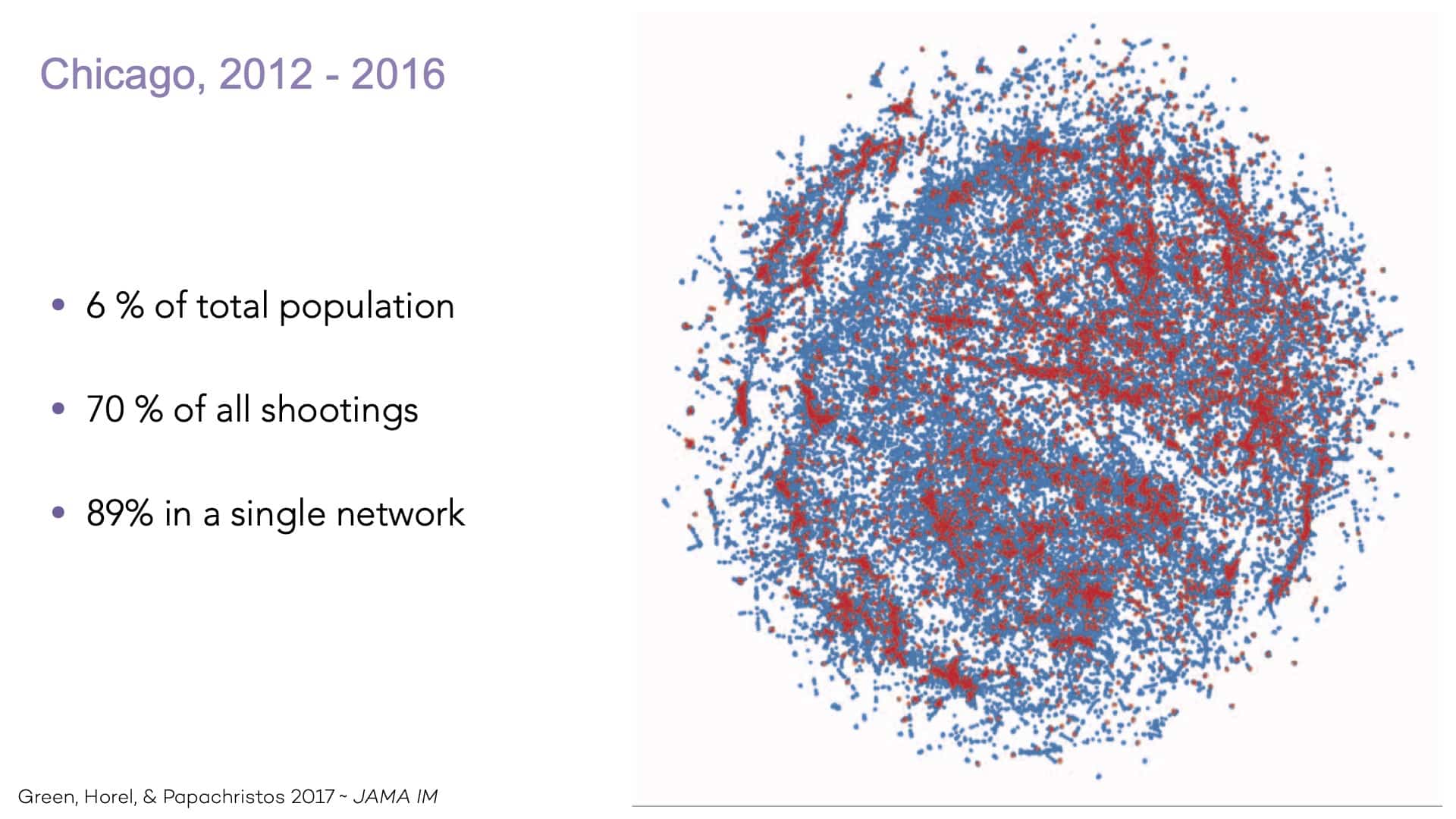
The social networks that Dr. Papachristos studies show that people affected by gun violence often share close social ties that have lasting consequences. When members of these networks face exposure to gun violence, it affects measurable aspects of their health, such as stress, sleep, and heart health. Additionally, people within these networks have a higher chance of becoming shot. While the probability of sustaining a gun injury is considerably higher for Black and Hispanic men in Chicago, the likelihood of becoming a victim rises exponentially when those men are in a social network where violence has previously occurred. Dr. Papachristos noted that a Black or Hispanic man between the ages of 14-24 within one of these networks has a higher chance of being shot than someone playing a game of Russian Roulette, in which the odds would be one in six. These figures helped frame the importance of understanding how social networks operate to the Fellows and how Fellows could utilize this information to reach members of the population facing the highest risk of becoming victims of violence.
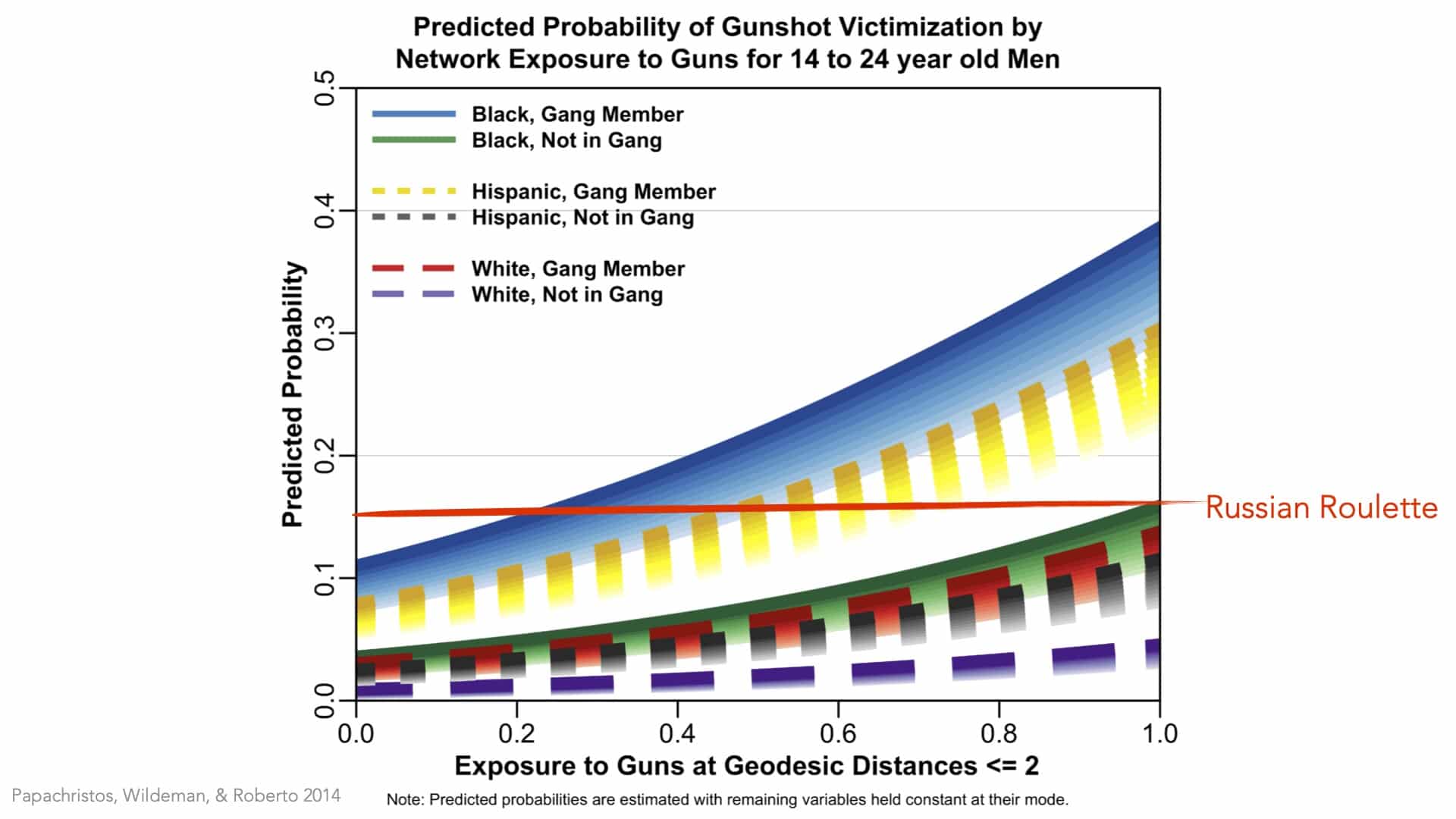
Dr. Papachristos’s research also illustrated that violence is contagious and that interrupting a potential shooting could have a cascading effect, preventing further instances of violence. He showed how he uses network science to track shootings that chain together within a social network. In Chicago, around 63% of shootings studied occurred within these chains of violence, with an average of 83-120 days between each instance. Each of the moments between these instances represents an opportunity for intervention, when victim services, trauma response teams, or outreach workers could coordinate efforts to stop the further spread of violence. When the number of responders is limited, this information is especially valuable because it helps them make the best use of their time.

As the Mutual Aid Collaborative network entered into discussion with Dr. Papachristos, many Fellows were interested in the root causes that might catalyze a cascade of community violence. Their conversation centered around the effectiveness of poverty abatement, after-school programs, and job programs in preventing future violence. Dr. Papachristos spoke to the need for community activists to take the time to understand root causes while simultaneously engaging in an immediate response to gun violence. He asked Fellows to consider that the average age of a victim of gun violence in Chicago is 27 years old. Examining a root issue such as schooling and primary education would not be doing much for the 27-year-old linked to a network in which gun violence has previously occurred. Systemic problems, such as poverty and education, demand attention, but solutions take time to implement and typically work to benefit future generations. Immediate answers to violence, such as street outreach work, are also needed for prevention.
The conversation between Dr. Papachristos and the Mutual Aid Collaborative network also touched on the importance of narrative when framing incidents of gun violence. Peace Fellows told powerful anecdotes about their work around gun violence and its impact on individual people. For instance, Lisa Daniels, a 2019 Chicago Peace Fellow, spoke about the importance of rewriting the narrative about "offenders" of gun violence. Addressing these narratives allows the "offenders" to understand themselves as victims before their offense rather than viewing themselves as intrinsically violent people. What she claimed is critical in conversations about trauma and healing is that we "remind the individual that they are not the worst thing they have ever done" and consider the “stories victims tell themselves about who they are and what they have experienced." Dr. Papachristos expressed that he tries to capture a similar sentiment in his presentations, referring only to "victims" of gun violence:
Nothing else should matter when you’re trying to save a life.
The meeting between Dr. Papachristos and the Mutual Aid Collaborative network linked rigorous empirical research into the structure of gun violence with the lived experiences of those who work in violence prevention. As community leaders reflected on the data Dr. Papachristos shared and its implications, they also envisioned its potential uses in their own violence prevention projects. A recurring theme throughout the presentation was that there is not a unilateral solution to the epidemic of gun violence, but that different people find different solutions which lift them and members of their communities outside of the cycle of violence. This insight stresses the importance of collaborative action amongst community activists, which the Mutual Aid Collaborative aims to facilitate. It is critical for grassroots partnerships to be created to provide individuals caught within networks of violence with a range of resources that can suit their diversity of needs.
Building a Community of Practice for First Call Pastors
2019 Chicago Peace Fellow, Pastor Robert Biekman, is piloting a Community of Practice with communities of faith. Pastor Biekman, or Pastor B., is utilizing the GATHER platform to foster peer-to-peer learning amongst newly ordained pastors and church planters. The majority of these pastors have been serving their congregations for less than three years and are gaining practical experience and building relationships through this cohort. This cohort represents an investment in the future of the church.
The GATHER mobile platform effectively facilitates shared learning and a curriculum for faith community leaders with a desire to build on the talents of their neighbors and the assets of their community.
Fifteen (15) pastors are using the GATHER platform to look beyond the walls of their congregations’ and engage their communities. GATHER’s mobile classroom and toolkit for building individual and community leadership capacity has allowed these active pastors to integrate the learning journey into their schedules.
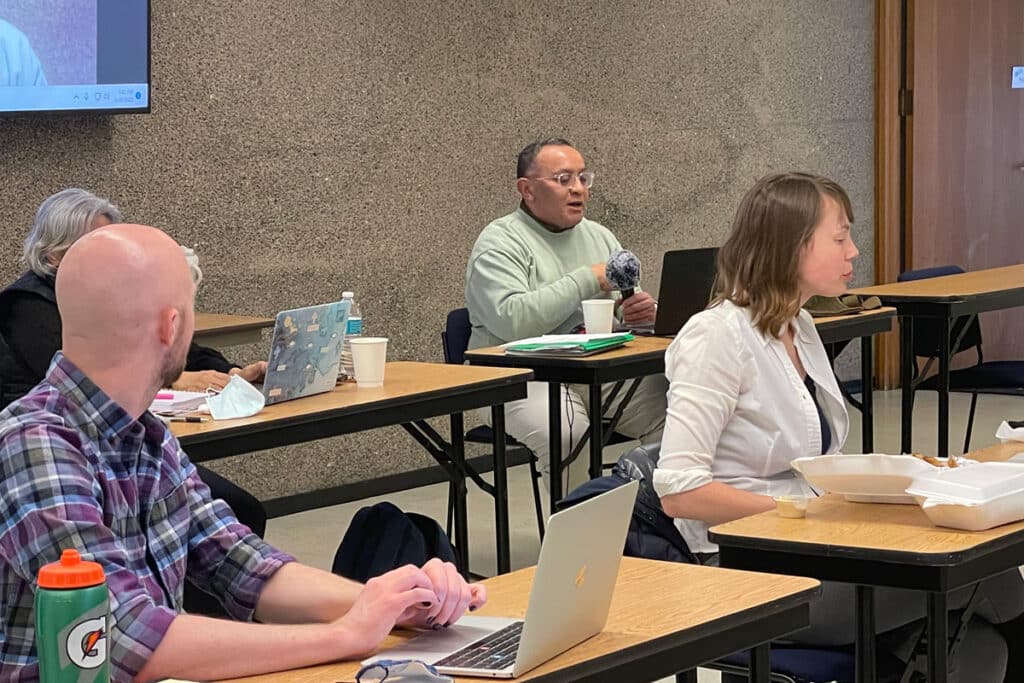
The inaugural cohort of pastors began meeting in March of 2022 and will complete their 9-month program in December. Reverend Colin Cranmer who serves as pastor at St. Mark Evangelical Lutheran Church in Elgin, Illinois shared,
"I have been engaged in this community of practice cohort for the last year and have truly enjoyed engaging with colleagues, asking critical questions about the community in which our church sits, and thinking from a 10,000-foot perspective of how God has specifically designed our church to engage...it's so comforting to know I'm not the only one struggling to understand the context of my church's culture and the community around me...Through this leadership community, I have received support and ideas to keep me going at each stage of the game. I highly recommend it!”
Reverend Colin Cranmer
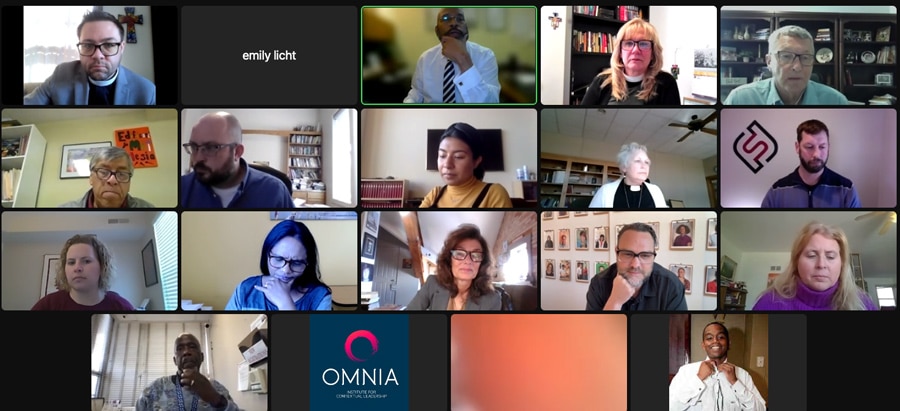
When Pastor Biekman was in the Peace Fellows program, he found value in the GATHER curriculum’s emphasis on collaboration and experience-based learning that he hopes to share with not only Lutheran but with faith leaders of other traditions. Creating a Community of Practice can potentially equip these pastors with practical knowledge of ministry and connect them with practitioner-experts.
As the first call pastors progress through the GATHER curriculum, they have two touchpoints with their Community of Practice each month: a roundtable, and a deeper dive into a subject such as asset mapping with an experienced practitioner. Through these regular meetings, the pastors discuss what work they will engage their communities in with one another.

During “touchpoint” meetings, pastors have shared successes and challenges as they work to connect with people outside their church walls. As pastors shared their experiences, they spoke to the successes of meeting their communities where they are, rather than just engaging them within the church itself.
The Reverend Maria Rojas Banda, who serves a predominantly LGBTQ+ Latinx congregation in Berwyn, Illinois spoke to the success of creating a walking group called caminando juntos—Spanish for “walking together.” Reflecting on the cohort, she said,
"The Workshops with different community leaders have been an excellent opportunity to see how other processes work in different contexts. The opportunity to read about my peers and connect with them is a great way to build up knowledge and relationships."

The GATHER program is customizable and can be accessed remotely as a self-paced curriculum. Pastor Biekman modified GATHER by crafting the opening reflection to approach each step of the “learning journey” through a theological lens. This has provided a common frame of reference for the pastors engaging with the material.
Additionally, the self-paced learning of the GATHER platform delivered in a hybrid format is accommodating for people’s various needs considering the COVID-19 pandemic. Combining custom material for first call pastors with a self-paced learning environment has created an inclusive Community of Practice that accommodates differences in capacity, while also uniting individuals around a common platform.
Pastor Pam Voves serves the people of Evanston, Illinois as pastor of St. Paul’s Lutheran Church, thinking about her participation with the cohort she says,
“I am grateful for the Community of Practice learning experience...the balance of expertise by veteran practitioners in the field of ministry and the cohort support from other pastors in my geographic area were most helpful...GATHER provided an easy-to-use platform...(and) also helped me connect with my pastoral colleagues outside the online sessions. The new ideas and relationships will stay with me as I continue pastoral ministry.”
Pastor Pam Voves
What has been essential to this Community of Practice is cooperation and partnership with the various expressions of the Evangelical Lutheran Church in America. Creating an accessible environment for grassroots leaders to partner with one another facilitates new partnerships and a broader community to be reached.

This pilot Community of Practice for Lutheran pastors and church planters is made possible through a Holy Innovation Grant awarded by the Evangelical Lutheran Church in America, Christian Community & Leadership Home Area.
Mutual Aid Collaborative Builds Connections with UChicago Medicine Violence Recovery Program
On Tuesday, July 19th, Peace Fellows and members of the community met with University of Chicago Medicine’s Violence Recovery Program (VRP). The event was held as part of the Mutual Aid Collaborative’s Civic Leader series, which aims to build connections between individuals and organizations that work to build peace and prevent violence. At their meeting, Peace Fellows spoke with Dr. Franklin Cosey-Gay, the Director of the VRP as well as Carlos Roble, a Clinical Lead/Social Worker in the VRP. Fellows learned about what the hospital does for victims of intentional violence as well as some of the root causes of violence that the Violence Recovery team hope to address.

Dr. Cosey-Gay walked Peace Fellows through the history of the Violence Recovery Program at the University of Chicago Medical Center and began by discussing the structural issues that the Program was designed to address. The VRP was started in 2018, with only two violence recovery specialists involved. The trauma center was created to provide more equitable access to high-quality health care and trauma treatment services on Chicago's South Side, specifically neighborhoods impacted by systemic violence. The VRP team views violence through a public health lens, which aims to address structural causes of violence, rather than blaming the individual. Because of this, the VRP seeks to make adjustments to the medical system that provide services to individuals affected by violence to promote equity and reduce the outbreak of further violence.

The Violence Recovery Team stressed that their framework of understanding violence through a public health framework goes beyond understanding treatment and rehabilitation on an individual level but also aims to prevent violence through examining relational, communal, and societal factors. Their presentation focused on why there are higher risk factors of violence on the Southside and particularly in predominantly Black neighborhoods. Chicago has a history of racial tensions that developed over time through restrictive covenants, redlining, urban renewal projects, and policing. These structural forces have deeply impacted South Side communities and the VRP is hoping to rebuild trust in public health institutions by gaining credibility and working with community based organizations. Meeting with Peace Fellows and members of the community acted as a way for the VRP to continue building credibility with organizations that work in violence prevention so that they can collaborate to address violence as a public health concern.
The Violence Recovery Program also operates on an individual level, acting to protect victims of violence and their families from disruptions that can be physically or emotionally harmful.
"Violence Recovery is about public health. We don't focus on fault or blame, we focus on prevention." -- Dr. Cosey-Gay
Dr. Cosey-Gay emphasized since the role of the Violence Recovery team is to act as public health professionals, they “neither determine fault nor place blame, but focus on prevention.” Oftentimes, social workers in the VRP act to keep police away from victims of violence so that they have time and space to heal and are given time to recover before questioning. Carlos Robles, a social worker in the VRP noted:
“We don't want to treat victims of violence as criminals, but as experts in their own lives.”
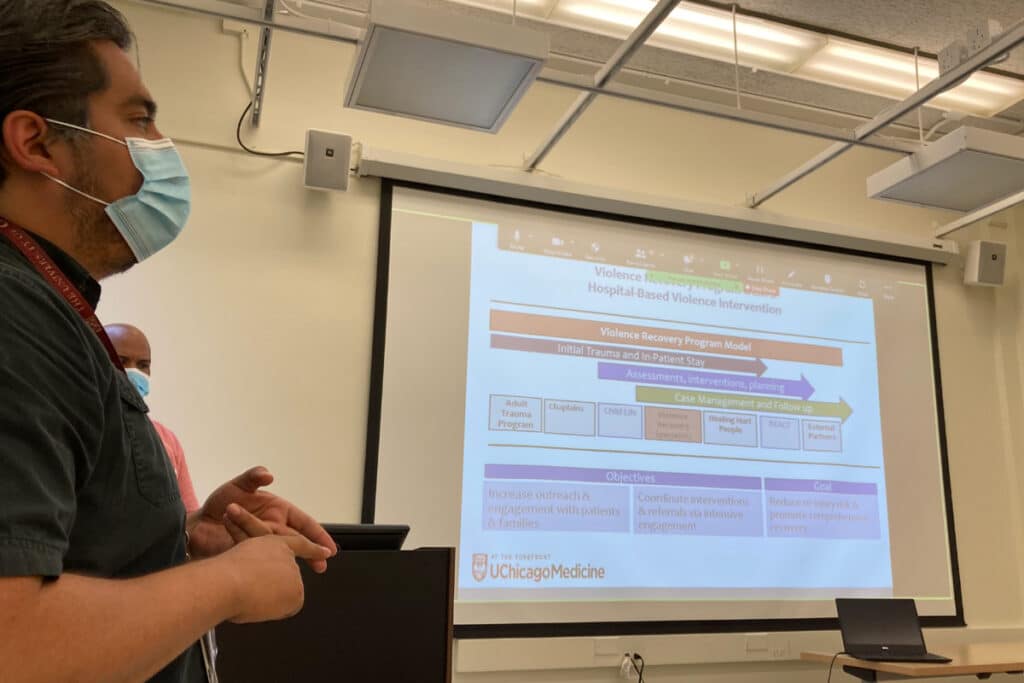
Today the Violence Recovery Program at University of Chicago Medicine has 15 full-time employees and offers 24-hour care to victims of intentional violence. Their care extends outside of the hospital as they also help patients and families navigate external health care and social services. As Peace Fellows and community members got to know the services of the VRP, they were surprised at the amount the program has grown in the last four years. Many of the attendees shared their own experiences navigating hospitals alongside victims of intentional violence and welcomed the new approach to violence recovery offered by the program. One attendee told a story about how she was not offered an opportunity to see her son’s body after he was the victim of violence and emphasized how traumatic this experience was for her. If a violence recovery program had been in place, some of the trauma of this experience could have been avoided and more trust could have been built between the hospital and the community.
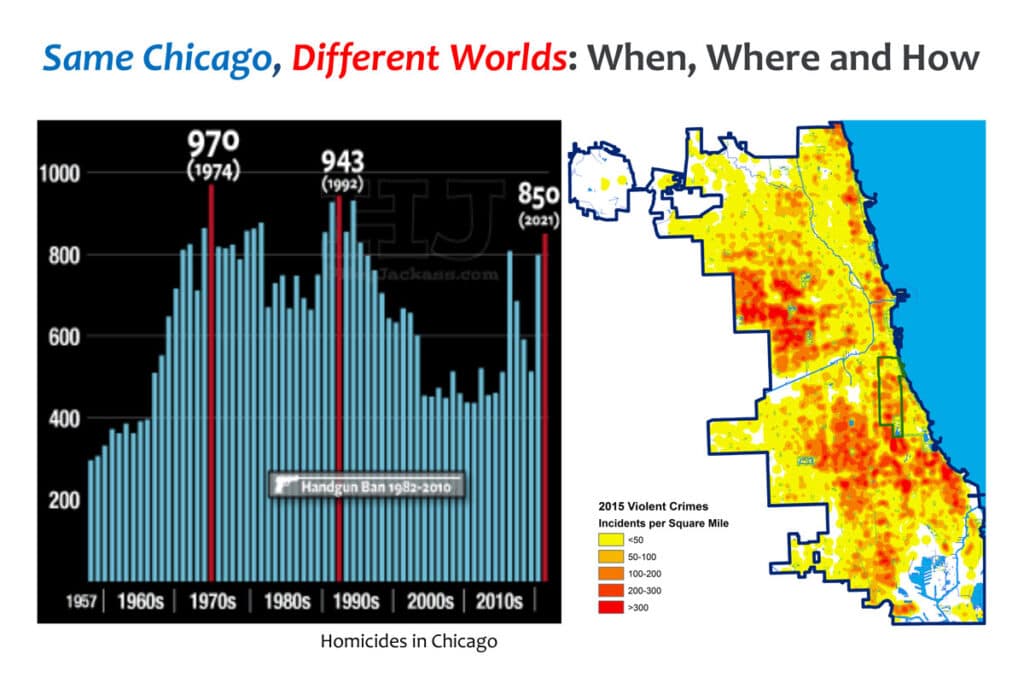
Getting to know the services and history of the Violence Prevention Program helped Peace Fellows and community members build a mutually beneficial relationship with the hospital. By gaining connections to community-based organizations the VRP builds credibility and gains new resources to direct victims of violence to with the aim of preventing further violence. Members of the community similarly benefited from learning about how approaches to treating intentional violence have improved over time and from gaining a better understanding of how the trauma center could treat members of their communities. Through this meeting, Peace Fellows gained new opportunities for collaborations that have the potential to bring lasting peace to their communities.
Moonset Sunrise Promotes Social Justice Through Theater
By Zeki Salah, Facilitator, Mutual Aid Collaborative
From June 8-18, Chicago Peace Fellow, Pilar Audain, acted as a guide for Moonset Sunrise, a theatrical experience rooted in healing, self-care and collective growth through song, storytelling, dance and ritual. Pilar co-created the program alongside the theater company Collaboraction as the inaugural event for Beat Kitchen's new restaurant/lounge and event space: Bar Sol.

Moonset Sunrise was conceptualized by Collaboraction, a social justice theater that builds knowledge, empathy, dialogue and action around oppression and inequity through live theater, film and online interactive programs. Pilar was approached by Carla Stillwell and Anthony Mosely of Collaboraction because they wanted to produce something that would promote healing and connection in the community and had heard of her experience doing ritual healing work. Pilar’s healing work on the Southside, as well as her use of ancient indigenous art forms as healing modalities attracted a lot of attention to her work and the team at Collaboraction asked her to be a priest in their latest production, Moonset Sunrise.

While the team at Collaboraction provided set design, musicians, dancers, and other artists, Pilar was tasked with creating a release experience for members of the audience. Pilar relied on audience participation to create a feeling of freedom and emotional release. For instance, at one point in the play, members of the audience were given a paper and pencil and asked to write down their emotions. They were then told to give the paper to a Goddess statue before the paper was burned by Pilar. By allowing space for emotional vulnerability and reflection, Moonset Sunrise aimed to provide audience members with an acceptance of who they are.

One of the goals of Moonset Sunrise was to make members of the audience feel as though they were entering a safe space and leaving their ordinary lives behind. Pilar and the team at Collaboraction aimed to create an atmosphere where people viewed different forms of art that elicited different emotions. Pilar’s vision of the set and performance were delivered by Collaboration “in the most organic and beautiful way.”

The set of the event included a mock sanctuary with running water that visitors encountered when they came into the auditorium. As audience members watched libations and sacred dances, they were encouraged to relax and focus on their breathing. By creating an immersive experience with different art forms, Moonset Sunrise provided audience members with a variety of modalities through which they could experience healing and release.
One of the outcomes of Moonset Sunrise was that people expected one thing and received what they did not know they needed. -- Pilar Audain Reed

She encouraged members of the audience to focus on the events that led them to their current positions, so that they could better understand themselves. During performances, many members of the audience expressed difficult relationships with loved ones and allowed for a breakdown of the emotional boundaries that are raised in everyday life. This freedom allowed them to focus on how they suffer in many of the same ways and helped them find a common humanity amongst themselves. By the time Moonset Sunrise concluded, many members of the audience were provided with a transformative experience that left them feeling a bit lighter and freer.
Safety Net Launches Blood Drive
By Zeki Salah, Facilitator, Mutual Aid Collaborative
Chicago Peace Fellows are working to address an increased demand for blood from Black and Brown donors through holding a Mutual Aid Collaborative Blood Drive. The Blood Drive is part of an ongoing Safety Net project by the Chicago Peace Fellows Mutual Aid Collaborative, a group of 60 Black and Brown leaders and committed allies who live and work in the communities they serve on the South and West sides. Fellows working on the Safety Net project seek to address multiple pandemics that ail the South and West Sides of Chicago, including COVID-19 and community violence.

The Safety Net campaign is accepting donation pledges until June 28th, but you can donate at any time after making the pledge. You can sign up for the Safety Net team’s blood drive here: https://sleevesup.redcrossblood.org/campaign/give-from-the-heart/
You can also promote the blood drive by using the hashtag: #OurBloodMatters
The Safety Net project started at the height of the COVID-19 pandemic by creating a distributed network of PPE providers throughout a grassroots network, but has since expanded its scope to include broader public health issues. Since its inception, the Safety Net project has also held COVID vaccine clinics to address the disproportionate impact of COVID-19 on Black and Brown communities. The Chicago Peace Fellows Blood Drive is the latest project by the Safety Net team and seeks to address a shortage of Black and Brown blood donors.

More Black and Brown donors are needed in the United States because of a rise in demand for some rare blood types that are more common in people of Black heritage. Certain subtypes of blood need to be matched to treat blood diseases such as sickle cell anemia. Blood donors are screened to see if they might possess certain rare blood types, which can also help match plasma and bone marrow donors. The demand for blood that the Safety Net team seeks to address is expected to increase even more during the summer, due to the increase of accidents such as car crashes and fireworks, as well as spikes in cycles of gun violence. This can put patients who need blood in consistent quantities at risk as these sorts of incidents risk depleting the blood reservoir that their treatments draw from.
The Safety Net wanted to bring attention to the need for a more diverse blood bank after learning that the director of the Chicago Peace Fellows, Burrell Poe, was diagnosed with aplastic anemia. Treatment for aplastic anemia requires bone marrow transplants, which can only be performed if the donor and recipient have matching subtypes of blood. In solidarity with Burrell, the Safety Net team scheduled their Blood Drive around his birthday, so that members of the community could be made aware of the importance of blood donations and their potential to transform the lives of other people.

Jacquelyn Moore of the Safety Net team donated blood in response to the blood drive and found the experience to be fulfilling as an altruistic act, while also gaining new insights into her own health. Jackie was touched by the campaign on a personal level because a blood drive saved her husband’s life after it connected him with a match for a stem cell transplant. She stated “giving blood provides a way to directly help the community and provides people with an opportunity to act, to improve the lives of people around them.” Additionally, Jackie noted the pragmatic benefits donors receive when giving blood. After giving blood, she was contacted by the Red Cross and given a report of her COVID-19 antibodies. She noted that the Red Cross also provides other reports on other aspects of the health of its donors and can act as a free health screening. At the screening, vital signs are checked and problems such as high blood pressure, arrhythmia, or low hemoglobin levels can be detected.
The Safety Net team’s blood drive campaign also seeks to dismiss myths about giving blood. They assert that giving blood is not painful, and can even be relaxing as it gives the donor an opportunity to sit back and take a break from the hustle and bustle of the day. Additionally, the Safety Net encourages members of the LGBTQ+ community to explore the possibility of giving blood, because many of the previous restrictions against donors within this community have been lifted. Lastly, the Safety Net team emphasizes the safety of giving blood, donation centers undergo strict COVID precautions and there is a low risk of contracting COVID while giving blood.
Second Annual Chicago Peace Fellows Music Festival
By Zeki Salah, Mutual Aid Collaborative Facilitator
The Chicago Peace Fellows held a Concert for Peace on June 4th, celebrating the artistic accomplishments of their communities and a shared commitment to improving their neighborhoods. The Second Annual Chicago Peace Fellows Music Festival was held at the Hatchery in Garfield Park with Peace Fellows gathering performers from across the city to play music, sing songs, read poetry, and dance. The Music Festival was organized by a committee within the Peace Fellows Mutual Aid Collaborative, a group of 60 Black and Brown leaders and committed allies who live and work in the communities they serve on the South and West sides.

The event was made streamed live on the Goldin Institute’s Facebook page where you can watch the recording.
The Music Festival Committee is made up of musicians and educators that have first hand experience with the transformative power of music and its positive impact on communities. The committee pooled their connections to create a lineup with a diversity of talents that represented neighborhoods across the city. The Peace Fellows Music Committee is made up of Peace Fellow Alumni from across the cohorts of 2019, 2020 and 2021: Gloria Smith of the Black Star Project, Angelina Zayas of the GAP Center, Juliet Jones of the Original 64th Street Beach Drummers, Margaret Murphy-Webb of the South Side Jazz Coalition, Marvinetta Penn of Global Girls, Inc., Rashada Dawan of B.Fli Productions, and Robin Cline of Neighborspace.

As musicians, artists, and educators, members of the committee had an eye for both talent and opportunity, bringing together talented members from their communities to perform. Many of the performers at the Peace Fellows Music Festival were young people for whom the festival provided an opportunity to gain experience performing, show off their talents, and be compensated for their time and effort. Additionally, by bringing together artists from across the city, the Peace Fellows Festival allowed for them to network with each other and collaborate in their artistic ventures.

The Peace Fellows Music Festival featured an eclectic range of performances, including jazz, hip hop, and classical music, as well as spoken word poetry and choreographed dances. Finding talent for the Festival was a collaborative effort, with multiple organizations spreading the word and connecting talent to the festival.
Performers included:
- Guru Tonic
- Heart Cry
- Kenya Braitwaite
- Mara Mitchell
- Global Girl Youth Company
- Phoenix
- The Original 64th Street Drummers
- Margaret Murphy-Webb
- MC Skool
- Ethan Clay
The Festival was held at the Hatchery, a non-profit food and beverage incubator which provided the space for free. While the Hatchery primarily serves to provide professional development to people in the food services industry, both the Hatchery and the Peace Fellows involved in the Festival have a common goal of connecting underserved communities with access to education, opportunity, and community resources.

The theme of peace was emphasized throughout the Festival as performers and organizers spoke to the importance of arts education, mutual aid, and community activism. Peace Fellows and their organizations were invited to set up tables and share information about their organizations for the first hour of the festival. This allowed for Fellows representing neighborhoods throughout Chicago to share resources with each other and network.

As the concert came to a close, 2020 Chicago Peace Fellow, Maragret Murphy-Webb, spoke to the importance of investing in arts education. She emphasized that the arts have the capacity to improve communities and combat violence: “If you put an instrument in a child’s hands, you can keep a gun out of their hands.” She encouraged audience members to engage with the City of Chicago and request more funding for arts and education in the South and West Sides so that underserved neighborhoods might have greater access to educational opportunities.

Through bringing together community members, providing them with opportunities, and affirming a collective commitment to peace through music and art, the Peace Fellows Music Festival sought to improve the communities represented by the Chicago Peace Fellows. Fellows’ commitment towards representing and improving their neighborhoods was pivotal to the Festival’s success.
